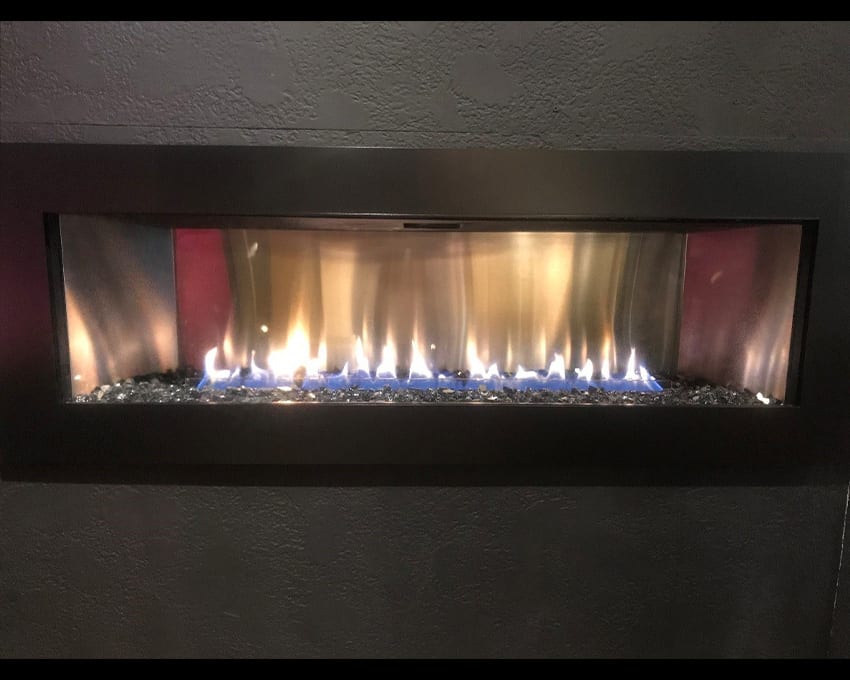Most gas fireplaces operate with a standing pilot light. But what does a pilot light do? Is it ideal for turning it off during the warmer months? How expensive could it be to keep your pilot light going year-round? Is it challenging to re-light if I turn it off?
Like most other Plano homeowners, if you have wondered about the small blue flame in your gas fireplace, you will find this information quite helpful.

What is the type of your ignition system?
Most gas-operated fireplaces will have a ceramic or tube style burner. The burner includes a gas valve, a control module, and various other fittings. When the remote controller is pressed, the thermostat on the wall starts calling for heat, or the world switch is clicked on, the gas valve gets open and allows gas to flow through the burner.
Right before your burner is the pilot light. This pilot light can be a “steady-on” pilot, an “intermittent,” or an electrical ignition system. The later type of pilot light is on only when the valve is open, and your fireplace is operational.
A millivolt valve utilizes a particular pilot light that is always lit, so leaving the pilot light on throughout the year will be confined to your millivolt ignition system. The Intermittent Pilot ignition, also known as the IPI system, can set the pilot to run continuously but is typically operated in the auto shut off mode.
The function of a pilot light
There are two crucial functions of a pilot light. One is to generate electricity; Millivolts that close and open your gas valve. And the second is to ignite the gas once the valve is opened.
How to turn off your pilot light on a gas fireplace
Before you go ahead and hit that “off” switch, you should first find out where your pilot light is located. Knowing the flame’s exact location will help you double-check if your flame has been turned off.
Ideally, the flame is located in the back or behind a few of your logs. If you cannot find the flame, the chances are that it’s already out.
Once you’ve located the flame, you can switch the knob from its original “pilot” position to the “off” position. Depending on your fireplace model, you may have to push a small lever out of your way before you can turn the dial.
Alternatively, you may have to push your valve in and then turn it into the “off” position. Make sure that you double-check the given owner’s manual to be sure.
After you’ve turned your dial to that “off” position, look to check if the flame has gone out. In case your flame is still on, the chances are that you have a faulty valve that needs to be repaired or replaced.
If you feel like you’re not sure what has to be done during the process, or if you would feel more comfortable with a professional doing the job for you, give Elegant Fireside a call. Located in North Texas, our team can answer any queries you may have regarding your gas fireplace.
How much gas does a pilot light use?
Should you turn your pilot off during summers? How much gas does a pilot light require?
Most pilot lights consume around 600 BTUs of gas every hour. If you leave your pilot light on for an entire day, it would roughly consume 14,400 BTU’s every day. This can further be calculated to figure out the total number of BTUs you will need per month to keep your pilot light running (approximately 432,000).
The measuring unit for natural gas is therms. Each term is equal to 100,000 BTUs of energy. This means that you will be using BTU’s equivalent to 4.3 therms of gas. Now apply a rate with each therm of natural gas. If you spend $.90 per therm, you will pay around $3.90 per month to keep your pilot light on. At $1.20 per therm, your monthly cost will land approximately $4.95.
The same calculation can be done to find out the cost for your LP gas. LP gas is measured in terms of gallons. There are 92,000 BTU’s per gallon. The price of one gallon of LP is $1.10, which means that you will have to pay roughly $5.20 every month to keep your pilot light on.
Advantages and disadvantages
There are a few advantages and disadvantages that come with leaving your pilot light on throughout the year. The most significant advantage is that if you are not using your fireplace for five months, you can easily save up to $20 or $30.
The small amount of heat that your pilot creates can help keep your firebox dry from the inside. This could be helpful if you live in a humid or damp climate.
Another advantage that comes with keeping your pilot light is to keep small and silky spider webs from blocking your pipes. If you have this problem, then $30 will probably not get you any service technician who would come to your home and fix it for you.
Shutting off your pilot light means it will have to be re-lit in the fall. The procedure to turn your light on is outlined in your owner’s manual. If you feel uncomfortable turning your pilot light on again, you can call in our professional from Elegant Fireside to do it for you.
Elegant Fireside in Plano Texas
We are one of the best, and only NFI certified fireplace companies in the area. Our services include retail sales, installation, and servicing. Our showroom features over 30 working fireplaces, making us the largest burning display showroom available to you in the Dallas area.
If you are looking for a fireplace, stoves and inserts, gas logs, gaslights, fire pit, grills and smokers, fire, and water features, then Elegant Fireside and Patio is the perfect destination for you.
Click here to get in touch with us today. We have been proudly serving the Metroplex for the past 30 years.

